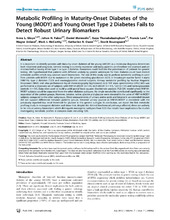| dc.description.abstract | It is important to identify patients with Maturity-onset diabetes of the young (MODY) as a molecular diagnosis determines both treatment and prognosis. Genetic testing is currently expensive and many patients are therefore not assessed and are misclassified as having either type 1 or type 2 diabetes. Biomarkers could facilitate the prioritisation of patients for genetic testing. We hypothesised that patients with different underlying genetic aetiologies for their diabetes could have distinct metabolic profiles which may uncover novel biomarkers. The aim of this study was to perform metabolic profiling in urine from patients with MODY due to mutations in the genes encoding glucokinase (GCK) or hepatocyte nuclear factor 1 alpha (HNF1A), type 2 diabetes (T2D) and normoglycaemic control subjects. Urinary metabolic profiling by Nuclear Magnetic Resonance (NMR) and ultra performance liquid chromatography hyphenated to Q-TOF mass spectrometry (UPLC-MS) was performed in a Discovery set of subjects with HNF1A-MODY (n = 14), GCK-MODY (n = 17), T2D (n = 14) and normoglycaemic controls (n = 34). Data were used to build a valid partial least squares discriminate analysis (PLS-DA) model where HNF1A-MODY subjects could be separated from the other diabetes subtypes. No single metabolite contributed significantly to the separation of the patient groups. However, betaine, valine, glycine and glucose were elevated in the urine of HNF1A-MODY subjects compared to the other subgroups. Direct measurements of urinary amino acids and betaine in an extended dataset did not support differences between patients groups. Elevated urinary glucose in HNF1A-MODY is consistent with the previously reported low renal threshold for glucose in this genetic subtype. In conclusion, we report the first metabolic profiling study in monogenic diabetes and show that, despite the distinct biochemical pathways affected, there are unlikely to be robust urinary biomarkers which distinguish monogenic subtypes from T2D. Our results have implications for studies investigating metabolic profiles in complex traits including T2D. | en_US |

